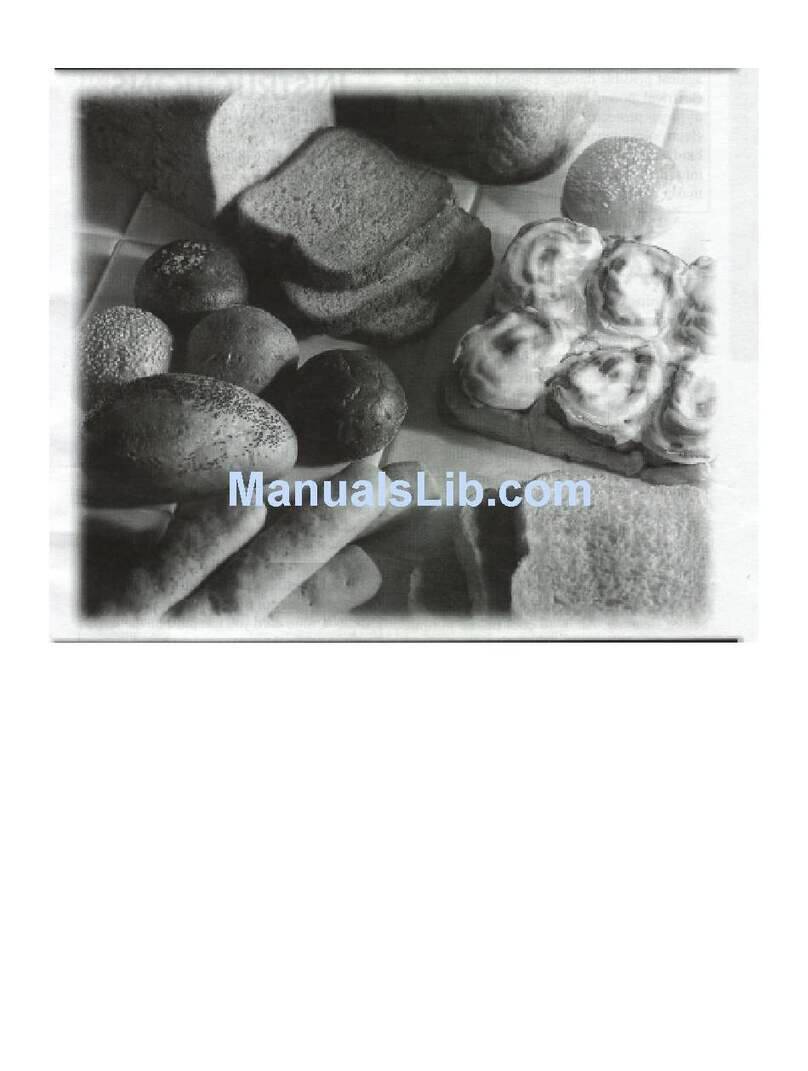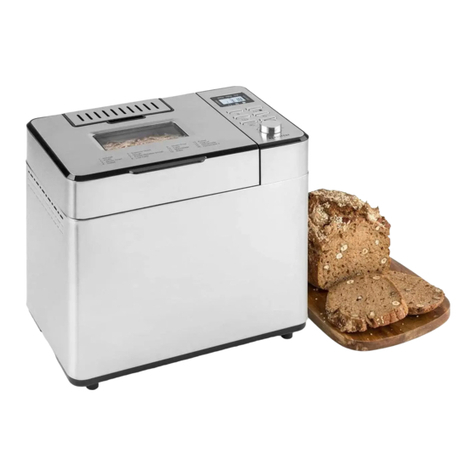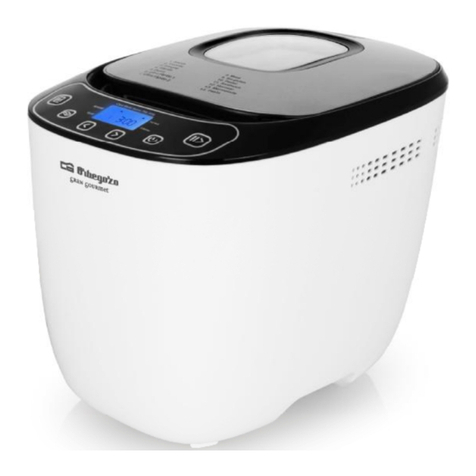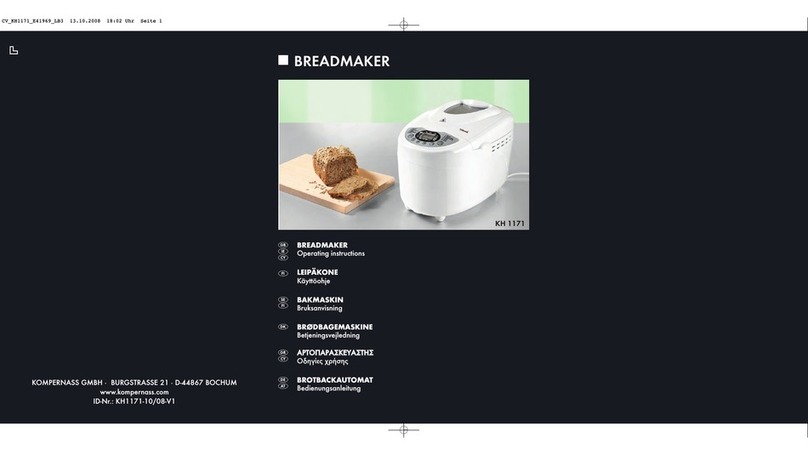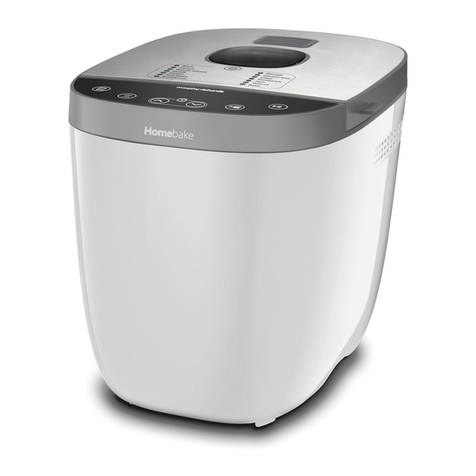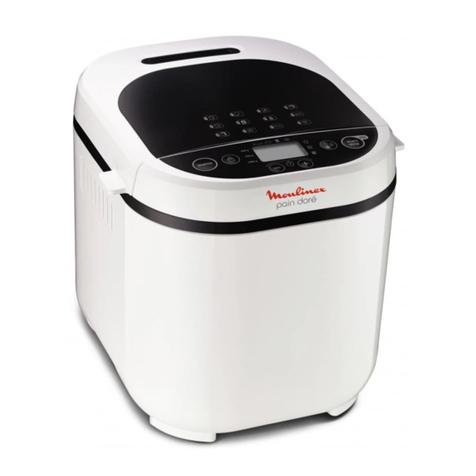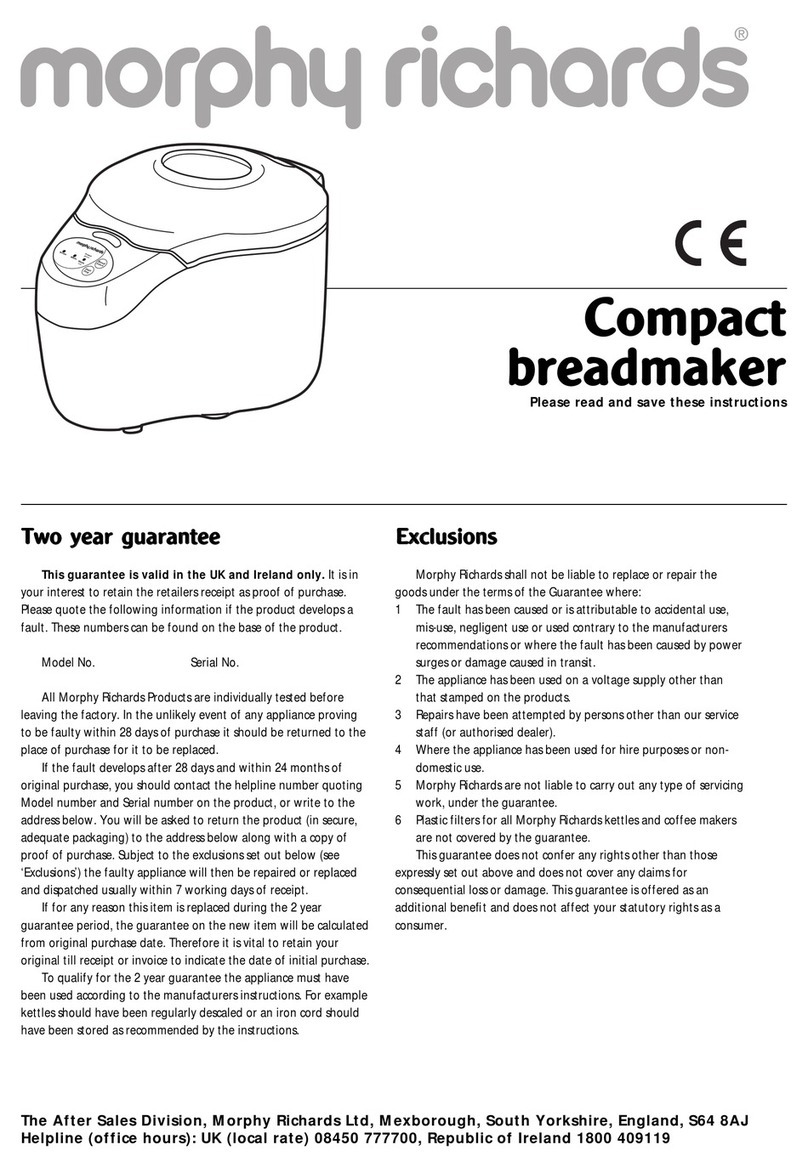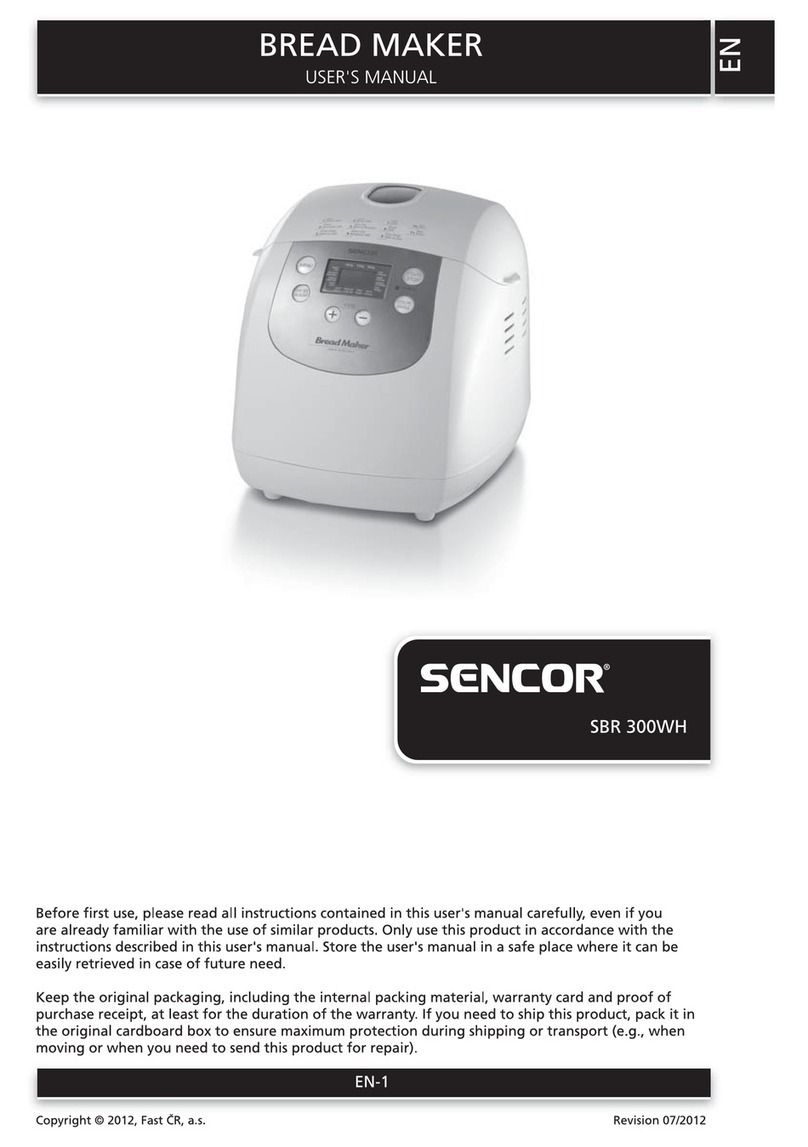Delta BB 1350 User manual

1
OPERATING MANUAL
FULLY AUTOMATIC BREADMAKER FOR
ALL KINDS OF BREAD DOUGHS,
BB 1350
Please read the instructions carefully before using the machine. You will find a range of
important and useful hints. Please keep the operating manual in a safe place and pass it on
with the machine to other users.

2
For technical reasons this page is empty

3
TABLE OF CONTENTS Page
CE Declaration of Conformity ................................................................................................4
General notes on safety ........................................................................................................5
Special notes on safety .........................................................................................................6
Areas of use ...........................................................................................................................7
Technical data .......................................................................................................................7
Items supplied .......................................................................................................................8
List of possible program variations .......................................................................................9
Preparation times (including preheating times where available) .........................................10
Description of equipment .............................................................................................. 11-12
Description of the display and operational controls ...................................................... 13-16
Heat retention function ........................................................................................................16
Memory in event of power failure ........................................................................................16
Ambient conditions .............................................................................................................17
Error messages on the LCD display ....................................................................................17
Before using for the first time ..............................................................................................18
Use of the breadmaker .................................................................................................. 18-20
Helpful hints .................................................................................................................. 21-22
Tips regarding recipes .........................................................................................................23
Recipes .......................................................................................................................... 24-29
Own recipes .................................................................................................................. 30-31
Cleaning ..............................................................................................................................32
Undesirable baking results – causes and solutions ............................................................33
Troubleshooting ............................................................................................................. 34-37
Warranty conditions ............................................................................................................38
Disposal ...............................................................................................................................39

4
CE DECLARATION OF CONFORMITY
Hans-Ulrich Petermann GmbH & Co. KG hereby declares that this pro-
duct complies with the following EU Directives: 73/23/EC, 89/336/EC and
89/109/EC and that this is confirmed by the CE marking.
The equipment meets the requirements of German Law on equipment
safety. This is shown by the GS symbol from an independent testing
institution:

5
GENERAL SAFETY ADVICE
This appliance may only be connected to a properly installed and protected
power outlet with supply voltage in accordance with the identification label.
Always unplug the appliance in case of malfunction, before cleaning and when
the appliance is not in use! Never pull by the power cable!
Never submerge the appliance in water and do not expose to rain or other-
moisture!
If the appliance should fall into water, only remove it from the water when the-
plug is removed from the socket! Do not use again until it has been inspected by
an authorised servicing centre. This also applies if the power cable or appliance is
damaged or when the appliance has been dropped.
Ensure that the power cable and appliance is never placed on hot surfaces or near
heat sources. Ensure that the power cable can not come into contact with hot or
sharp-edged objects.
Never use the appliance when standing on a wet floor or when your hands or
the appliance are wet.
Do not kink the power cable or wind it around the appliance.
Do not leave the appliance unsupervised during operation!
Repairs must only be performed by authorised customer service centres. Never
attempt to open the appliance or insert metallic objects etc. inside.
If the appliance is not used as intended or operated incorrectly, we accept no
liability for any resulting damage!
Never use the appliance outdoors, as it may be exposed to rain or other wa-
ter!
Electrical appliances are not toys! Use and store the appliance out of reach of
children. Do not leave the connection cable hanging down.
Do not allow children to operate this appliance.
If the power cable is damaged it must, for safety reasons, be replaced by an autho-
rized servicing centre.
This appliance is not designed for commercial use, but exclusively for use in
the domestic household!

6
SPECIAL NOTES ON SAFETY
WHEN USING BREADMAKERS
Do not stand the equipment on hot surfaces or near sources of heat. It should
not be placed beneath wall cupboards or too near the wall, to avoid a build-up
of heat.
Bread can burn! Never stand your breadmaker near highly flammable materials,
such as near or beneath net curtains!
Only stand the breadmaker on a heat resistant, level, non-slip area of your
kitchen worktop.
Never place anything on the machine or cover the vents. Heat and steam must
be able to escape freely, otherwise heat will build up and may damage the
equipment. Covering the vents also constitutes a fire hazard.
Use the equipment only for making bread or preparing doughs and jams, and
not for any other purpose!
Do not insert bulky foodstuffs, metal foil or the like into the machine to avoid
damaging it.
Use only the accessories provided. If you use parts made by other manufacturers
you will forfeit your entitlement to cover under the warranty.
Never use more than the quantities given in the recipes provided in the ope-
rating manual.
Never try to remove ingredients or dough from the breadmaker when it is
switched on!
Never remove the baking pan while the machine is in operation! Never touch a
rotating kneading hook – risk of injury!
Do not touch the baking pan or kneading hook with pointed or sharp objects.
If the non-stick coating of the baking pan or of a kneading hook is damaged
by improper use please refrain from using the part concerned. You can obtain
kneading hooks and baking pans from the customer service address at reaso-
nable cost.
Use the baking pan with the utmost care. Always remove the baking pan from
the machine when adding ingredients, to avoid spillage on the baking chamber.
Burning dough is a fire risk!
Pull out the plug immediately if you notice unusual smoke, steam or smells. The
dough may have overflowed onto the heating element. Ensure that the outside
of the baking pan and the baking chamber are always clean.

7
The surface of the equipment lid may become hot to the touch. Proceed with
care. To remove the dough container always use an oven cloth or glove.
Do not relocate the equipment when the dough container is full of hot liquid
(jam).
THE EQUIPMENT CAN BE USED FOR:
1) Kneading dough, e.g. for rolls or cakes and pastries.
2) Making bread according to the attached recipes or according to recipe books on
the market.
3) Processing baking mixes.
4) Making jam.
TECHNICAL DATA
Rated voltage: 230 V
Rated frequency: 50 Hz
Rated burden: 850 W
Level of protection: I
Basic program: 11
Program variations: 134
Timer: up to 13 hours’ baking delay
Heat retention function: 1 hour
Memory in the event of power failure: 15 minutes
Loaf sizes: 0.75 kg, 1.00 kg, 1.35 kg
Kneading hook and baking pan: non-stick coating

8
ITEMS SUPPLIED
1 Breadmaker
2 Kneading hooks and 1 baking pan
1 Measuring beaker
1 Measuring scoop (teaspoon/tab-
lespoon)
1 Tool to remove baked-in kneading
hooks
1 Operating manual without illustra-
tions

9

10
Preparation times
Program Total time ** Program sequence
*Adding of ingredients at point ** possible only with these programs
Program run time calculated without heat retention time

11
DESCRIPTION OF
EQUIPMENT
I
A
B
C
D
E
F
G
H
Breadmaker:
A) Casing lid
B) Control panel
C) ON/OFF switch
D) “COOL TOUCH” casing
E) Baking pan, non-stick coated
F) Baking chamber
G) Handle for removing baking pan
H) Kneading hook, non-stick coated
I) Viewing window

12
Operating buttons:
J) LCD display
K) Select button [“Bread size”]
L) Select button for degree of browning [“Colour”]
M) Select button [“Time +”]
N) Select button [“Time –”]
O) Select button [“Menu”]
1 = Basic
2 = Quick
3 = French
4 = Rapid
5 = Whole wheat
6 = Sweet
7 = Dough
8 = Bake
9 = Jam
10 = Sandwich
11= Gluten free
P) Select button [“Start/Stop”]
Q) List of basic programs 1 – 11
LCD-Display:
R) Display symbol for selected degree
of browning
S) Display symbol for selected loaf size
T) Display of operating time, dependent
on program selected
U) Display of basic program selected
O
UT
R S
N
M
L
K
J
Q
P
light medium dark 0.75 kg 1.00 kg 1.35 kg
1 = Basic
2 = Quick
3 = French 4 = Rapid
5 = Whole wheat 6 = Sweet
7 = Dough 8 = Bake
9 = Jam 10 = Sandwich
11= Gluten free
light medium dark 0.75kg 1.00kg 1.35kg

13
The relatively long time of 2-3 seconds prevents you from ending the program pre-
maturely by touching the “Start/Stop” button inadvertently.
Select button
Please note that for programs marked with a star (*) the stirrer has a built-in
delay (preheating function). You will find details of the appropriate preheating
time in the table on Page 10 in the “preheating” column.
This button is used to select the desired programs (1-11). Each time a button is
pressed you will hear a bleep, and the place in the program will be moved forward
by one point. Note the explanation of the various basic programs below:
1 = Basic*:
This program is used to process (knead, allow to stand, bake) mixed and white
breads, consisting of wheat flour and/or rye flour.
2 = Quick:
“Quick” breads are baked with baking powder or bicarbonate of soda, which is acti-
vated by humidity and heat. We recommend that you firstly add all liquid ingredients
and then the dry ingredients to the baking pan. Lumps could form in the corners of
the baking pan because of the shorter program time. We therefore recommend that
you break down the lumps of flour using a suitable baking spatula, if necessary. The
bread is made in a decidedly shorter time; we therefore recommend that you only use
recipes with basic bread ingredients (water, milk, eggs, possibly butter or margarine,
flour, salt, sugar). The program is not suitable for breads with special ingredients.
Please consider that bread on this setting is generally somewhat smaller and not
as light.
DESCRIPTION OF THE DISPLAY AND OPERATIONAL
CONTROLS
Select button
You may start or interrupt the selected program using this button. To start, press the
button once. You will hear a short bleep, both dots on the digital display will start to
flash and the program will begin.
Menü
All other buttons, with the exception of
the “Start/Stop” button, are deactivated
after the program has started, i.e. not
functional for safety reasons.
To stop the program, hold the button down
for about 2-3 seconds until a short whist-
ling sound informs you that the program
has ended.
light medium dark 0.75 kg 1.00 kg 1.35 kg
Menu

14
3 = French*:
This program is used to process doughs with longer standing phases. For light,
crustier breads made of white, heavily ground flour (mostly Type 405).
4 = Rapid*:
This program is used for making breads quickly. This program has no facility for
baking the bread later; see list of possible program variations on Page 9.
5 = Whole wheat*:
This program is used to make breads with a high proportion of rye and wheat whole-
grain flour, oats or bran. On this setting the longer preheating phase is used to allow
the “grains” to absorb water more easily and to open up (sunflower seeds, sesame
seeds, linseed, etc.).
The bread is therefore smaller, denser and heavier than comparable light breads. We
do not recommend baking on a timer with this program as the quality of the bread
could be adversely affected.
6 = Sweet*:
This program is used to make sweet bread, e.g. with fruit juice, sugar, coconut flakes,
raisins, dried fruits or chocolate.
7 = Dough*:
This program is used to make dough (kneading and allowing to stand) but without
the bake function. The dough can, for example, be used to make pizzas, plaits and
rolls.
8 = Bake:
This program is only for baking doughs, without kneading or allowing them to rise
(e.g. doughs which you have previously mixed or whose preparation has been in-
terrupted by a lengthy power cut).
This program can also be used to rebake a bread which is too light or possibly not
baked thoroughly enough.
Note: the preset time cannot be changed on this program. Press the “Start/Stop”
button on the equipment if you wish to end the baking process prematurely.
9 = Jam*:
This program is used to make home-made jam.
10 = Sandwich*:
This program is used to make sandwich bread and to bake light bread with thinner
crusts.
11 = Gluten free*:
This baking program is particularly suited to the baking properties of gluten-free
flour mixes or types.

15
Select button
for degree of browning
This button is used to select the desired
crust colour: light, medium or dark. Every
time the button is pressed the arrow in
the LCD display moves up one browning
level.
Select button
This button is used to select the desired
bread weight. Press the button until the
arrow in the digital display appears be-
neath the desired weight (0.75 kg, 1.00
kg, 1.35 kg).
Farbe
Brotgröße
Zeit +
Zeit –
Please note that the breadmaker has been preset as standard to the 1 kg size.
By pressing the “Loaf size” button you can change the current programming
time in the LCD display, depending on the weight of bread selected. See the
list of individual preparation times on Page 10.
Because of loss of liquid during baking, the weight of the ingredients is usually greater
than that of the finished bread.
Select buttons
If you do not wish the breadmaker to begin immediately you may set the desired
total delay time by pressing the above buttons. The maximum delay time which can
be set is 13 hours. This function is used to ensure that freshly baked bread is ready
at the desired time (e.g. for breakfast).
Note: The delay time includes the relevant baking time, irrespective of the
program selected.
Before setting the time delay you must first of all choose the desired program
and the degree of browning (“colour”).
Every time the “Time +” button is pressed the delay time is increased by 10 minutes,
and when the “Time –” button is pressed it is reduced by 10 minutes. The fixed ba-
king times for the different programs are neither increased nor shortened by these
settings.
light medium dark 0.75 kg 1.00 kg 1.35 kg
light medium dark 0.75 kg 1.00 kg 1.35 kg
Color
Bread size
Time Time

16
Example:
It is now 20:30 and you would like the bread to be ready for the next morning at 7:00,
i.e. in 10 hours and 30 minutes’ time. First of all select the desired program, the de-
gree of browning and the desired loaf size. Then press the “Time +” button or “Time
–” button until “10:30” appears in the digital display. Now press the “Start/Stop”
button to start the time delay program. The colon in “10:30” begins to flash and the
remaining time is counted down in the LCD display.
If, for example, you have chosen the wholegrain bread program “5” and a loaf size
of 0.75 kg (program run time: 3 hours 40 minutes) the breadmaker will be in ready
mode for 7 hours and will begin the program during the night at 3:20.
Next morning at 7:00 you will have fresh bread. If you do not wish to remove the
bread from the baking pan immediately at the end of the program, the bread will be
kept warm for 1 hour using the built-in heat retention function.
Do not use any easily perishable ingredients for baking on time delay, e.g. eggs,
fresh milk, fruit, onions, etc.
HEAT RETENTION FUNCTION
When the baking process has ended, the bread will be kept warm automatically
for 1 hour. This prevents the inside of the bread becoming “soggy”. If you do not
wish to use this additional function please press the “Start/Stop” button to end the
program manually.
MEMORY IN THE EVENT OF POWER FAILURE
If there is a short power cut during the program the selected settings will automatically
be stored for about 15 minutes. If the mains power returns within 15 minutes the pro-
gram will continue automatically without the “Start/Stop” button having to be pressed
again. If the power cut lasts longer than 15 minutes the contents of the memory will
be lost and the breadmaker will have to be restarted (from the beginning).
If the longer power cut has occurred during the kneading/standing phase the pro-
gram may be started again (from the beginning) by simply pressing the “Start/Stop”
button.
If a longer power cut has occurred during baking the baking process may be com-
pleted by using Program 8 (bake only).

17
AMBIENT CONDITIONS
The breadmaker will function WITHOUT any problems within a wide range of tem-
peratures but there may be differences in the size of the loaf if the room is very hot
or very cold. The best results will be obtained at room temperatures between 15
and 34oC.
ERROR MESSAGES ON THE LCD DISPLAY
If the message shown appears after the
machine has started, the temperature in
the baking chamber of the equipment is
too high. In this case stop the program,
open the lid and allow the breadmaker to
cool down for about 20-30 minutes. After
that the equipment may be restarted.
If the following message appears after
the machine has started, the temperature
sensor has malfunctioned. In this case do
not continue to use the machine but send
the machine to the authorised customer
service address for servicing.
The display shown here will appear if the
machine is operated in an environment
that is too cold. After it has appeared you
will hear 5 bleeps at intervals.
Then the machine will switch to the normal
display for setting the desired program and
loaf size. However, it will not be possible
to start a program.
This is a safety function because the yeast
in the bread dough does not rise at an
ambient temperature that is too low.
light medium dark 0.75 kg 1.00 kg 1.35 kg
light medium dark 0.75 kg 1.00 kg 1.35 kg
light medium dark 0.75 kg 1.00 kg 1.35 kg

18
BEFORE USING FOR THE FIRST TIME
Carefully remove the breadmaker from its packaging and clean the baking pan, the
kneading hooks, the measuring beaker, the measuring scoop and the removal tool
in hot water using washing-up liquid or alternatively in a dishwasher (see also notes
in the CLEANING section). Then rinse well and dry.
Place the machine near a power socket. Take care that you have a level, dry, non-
slip and heat-resistant surface on which to stand it. Then plug the machine in and
activate the ON/OFF switch on the side beneath the operating buttons, bringing it
to position “I”.
Before using for the first time please carry out a 10 minute test bake, using the baking
pan and kneading hooks (without ingredients) with the lid down. To do this activate
the “Menu” button until the program place “8” appears in the LCD display. Then press
the “Start/Stop “ button briefly. You will hear a short bleep, and the breadmaker will
begin to heat up. To switch off the heating process press the “Start/Stop” button
again for about 3 seconds. The switching off of the heating element will again be
signalled by a short whistle. Then please switch the machine off by returning the
ON/OFF switch to the “O” position.
It is quite normal for a slight smell and a little smoke to be produced at this point
(sealing of heating element during manufacture) and is not a problem. Despite this
ensure there is sufficient ventilation and clean the baking pan and the kneading hooks
once again in hot water with a little washing-up liquid. Then rinse well and dry.
USE OF THE BREADMAKER
1) First insert the two kneading hooks into the driving axles in the dough container
and turn the kneading hooks in a clockwise direction until they click into the
axles.
We recommend smearing the bare ends of the driving axles with a small amount
of margarine suitable for baking so that the dough does not stick to the axles
and the kneading hooks can be released from the bread more easily later on.
2) A long bleep will sound during the program for the programs listed below:
> Basic < after about 25 minutes (*)
> French < after about 25 minutes (*)
> Whole wheat < after about 25 minutes (*)
> Sweet < after about 15 minutes (*)
> Sandwich < after about 13 minutes (*)
A bleep while the program is running (see Point 2) means that more ingredients (e.g.
nuts, raisins, linseeds, caraway seeds, dried fruit, etc.) may now be added.
(*) the exact times
can be seen in the
list of preparation
times on Page 10.

19
3) Now place the chosen ingredients into the dough container.
Take the greatest possible care when using the baking pan. When adding the
ingredients always take the baking pan out of the machine, to avoid spilling
onto the baking chamber. Risk of fire from burning dough!
Keep to the order given in the relevant recipe:
a) First of all the liquid ingredients are placed in the baking pan, e.g. milk, water,
oil, eggs, soft butter or margarine.
b) The dry ingredients are firstly mixed together, e.g. flour, salt, sugar. Then the
mixture of dry ingredients should be added to the liquid in the baking pan.
c) Always make the yeast or baking powder the last ingredient to go into the
container.
Use only dried yeast! Never add this to liquid but always to dry ingredients,
in a small hollow made in the centre of the dry ingredients. (The yeast might
otherwise be prevented from rising, particularly if the baking process is delayed
using the timer).
4) Now place the baking pan in the breadmaker in the centre of the baking cham-
ber and press downwards gently until you hear it click into place. Fold down the
handle of the dough container.
5) Now carefully close the lid of the machine and connect the mains cable to an
earthed socket installed in accordance with the regulations.
6) Now switch the machine on using the ON/OFF switch located on the side of the
machine (under the operating buttons). Switch to “I”.
7) Now press the “Menu” button to select the desired program.
8) To select the desired degree of browning press the “Colour” button.
9) To select the desired loaf size (0.75 kg, 1.00 kg. 1.35 kg) press the “Loaf size”
button.
10) If necessary, now set the desired time delay by pressing the “Time +” or “Time
–” buttons.
11) Finally press the “Start/Stop” button to start the program.
12) A bleep during the program – see Point 2 – means that more ingredients (e.g.
nuts, raisins, linseed, caraway seed, dry fruit, etc.) may now be added.
Open the lid of the machine only to add ingredients. If you open the lid too often
the bread may collapse.
During the baking process there may be steam coming from the ventilation
openings on the machine lid. This process is normal and is not a cause for
complaint.

20
13) At the end of the program you will hear about 8 – 10 bleeps. This signals the end
of the program and the machine has now switched to heat retention mode. If
you would like to take the bread out immediately press the “Start/Stop” button
for about 2-3 seconds to end the program manually.
The equipment, the baking pan and the bread are – when removed immediately
– very hot. Always use oven cloths or gloves. Do not grasp the machine, the
baking pan (including handle) or the bread with bare hands!
14) Open the lid and pull up the baking pan from the baking chamber using the
handle. Tilt the baking pan and shake it carefully so that the bread falls out. If
possible allow the bread to cool on a cooling tray. Generally the bread can be
removed easily because of the non-stick coating on the baking pan. If the bread
is stuck fast loosen the bread from the edges of the dough container using a
baking spatula made of plastic or wood.
15) Switch the machine off (ON/OFF switch in “O” position)
Never use a knife or other metal objects to loosen the bread. This may damage
the non-stick coating.
After removing the bread check immediately whether the kneading hooks have re-
mained in the bread. The kneading hooks are baked in and may remain in the loaf
when it is removed.
16) Never forget to remove the kneading hooks before the bread is sliced. Otherwise
the hooks could be damaged. Baked-in kneading hooks can be pulled from the
bread using the removal tool provided.
If the bread is still hot the removal of the kneading hooks is simple. However,
the hole which appears is somewhat bigger than with cool bread.
Leave the breadmaker to cool for about _ hour with the lid open and switched off
(ON/OFF switch on side to “O” position) before you bake more bread.
If you do not wish to bake any more bread always return the ON/OFF switch on the
side to the “OFF” position (“O” setting) and also pull the plug from the socket.
Table of contents
Popular Bread Maker manuals by other brands

Mister Loaf
Mister Loaf HB211 Instruction manual & recipes
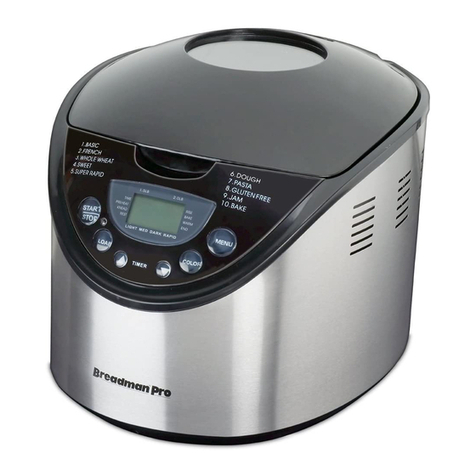
Breadman
Breadman TR875 Instruction manual & recipe guide
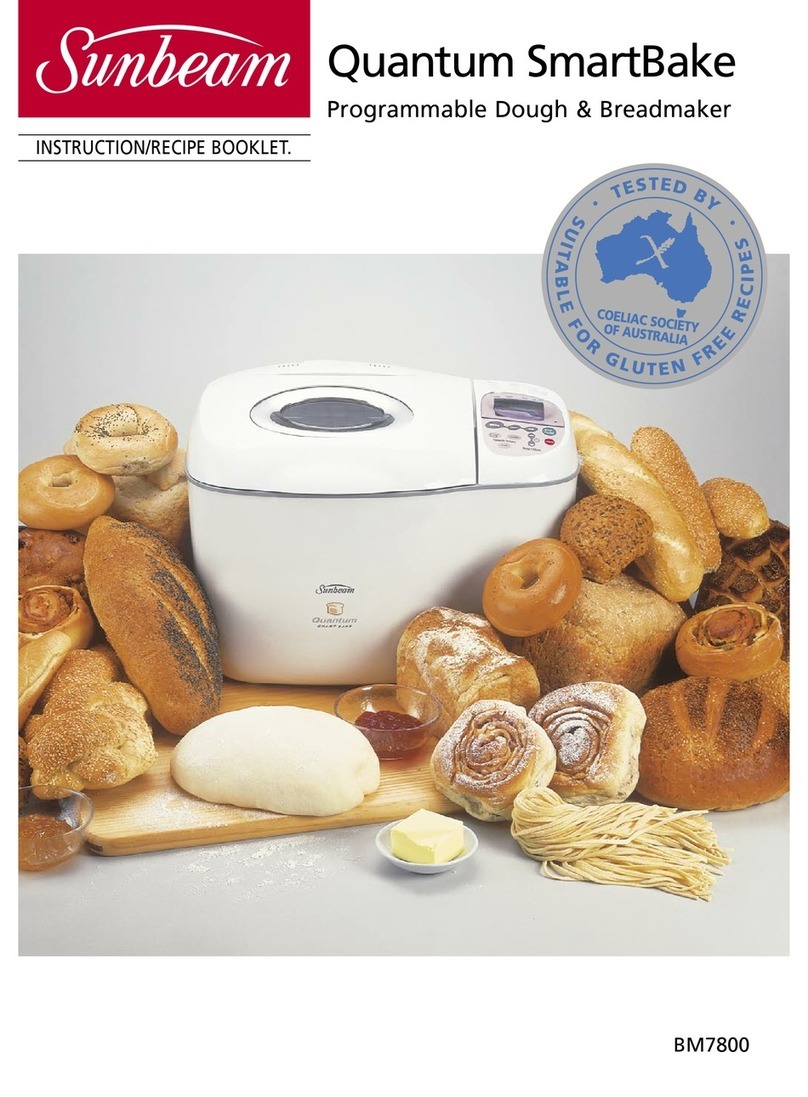
Sunbeam
Sunbeam BM7800 Quantum SmartBake Instruction/recipe booklet
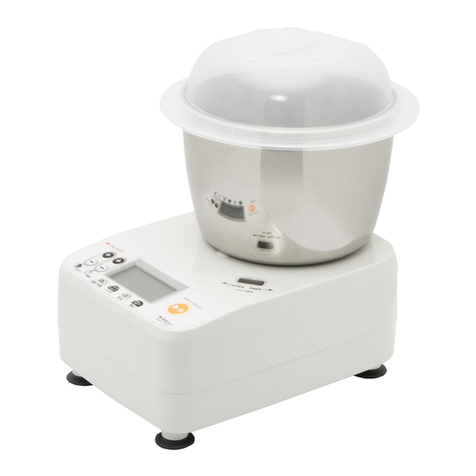
Kneader
Kneader PK1012W user manual
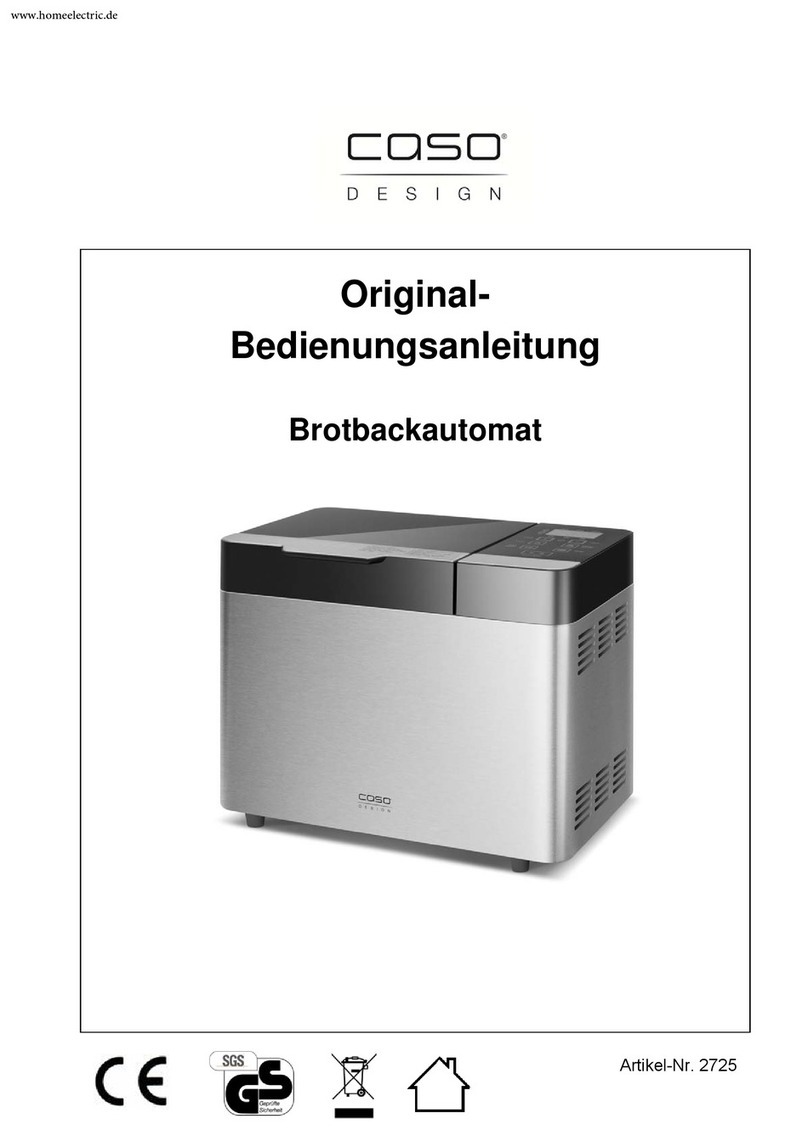
CASO DESIGN
CASO DESIGN BM 1000 Original operating manual
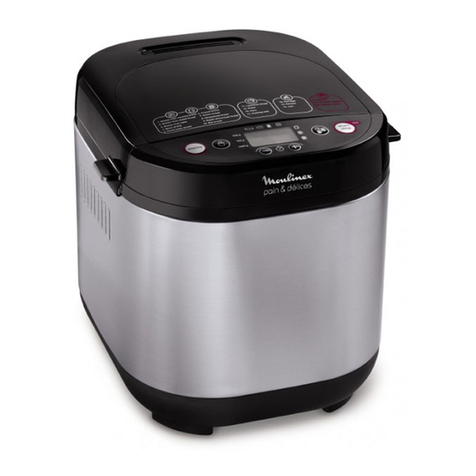
Moulinex
Moulinex Pain Plaisir Series manual
